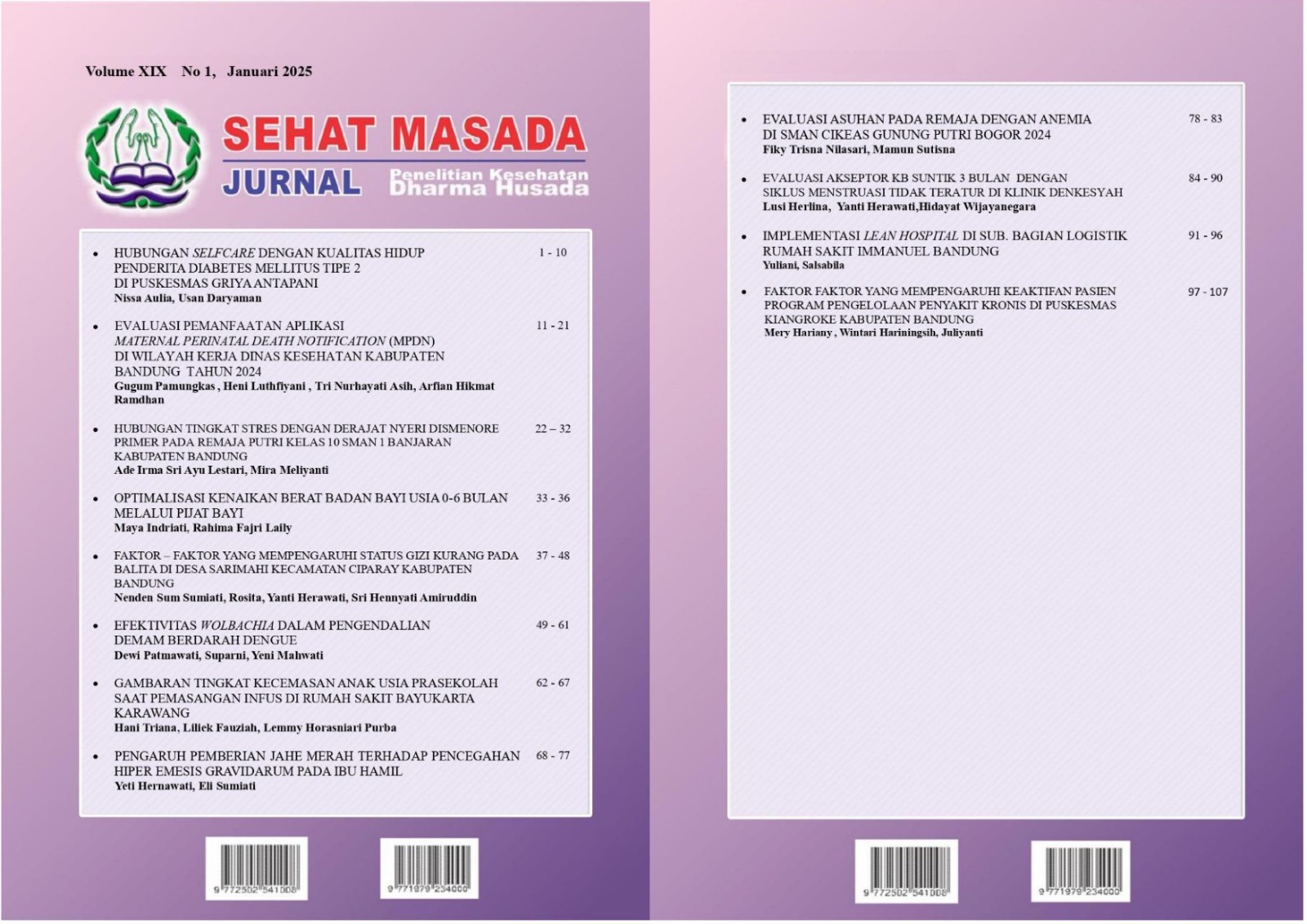EVALUASI ASUHAN PADA REMAJA DENGAN ANEMIA DI SMAN CIKEAS GUNUNG PUTRI BOGOR 2024
Abstract
The global prevalence of adolescent anemia ranges from 40-88%. The incidence of anemia in adolescent girls in developing countries is around 53.7% of all adolescent girls, the largest prevalence occurs in African and Southeast Asian countries, (WHO, 2018)The prevalence of iron nutrition anemia in adolescent girls in Indonesia is 22.7%. (Indonesian Ministry of Health, 2021). Data from the 2012 Household Health Survey (SKRT) stated that the prevalence of anemia in adolescent girls aged 10-18 years was 57.1% and aged 19-45 years was 39.5%. Women have the highest risk of developing anemia, especially adolescent girls, which states that in 2012 the prevalence rate of anemia in adolescent girls in West Java was 51.7%, which is the highest prevalence among other provinces. Based on the data obtained, it is known that adolescent girls with risk of anemia in the Sman Cikeas Gunung Putri Bogor area are still fairly large, namely 25 people out of a total of 35 total samples interviewed.
The research method used in this study is descriptive research, analytic with a qualitative approach cross sectional design, where the collection of independent variables and dependent variables is carried out at the same time. The research location was at Sman Cikeas Gunung Putri.The research subjects were all adolescent girls at Sman Cikeas Gunung Putri, Bogor. Data collection techniques used in this study were primary and secondary data collection techniques.
Evaluation Results from interviews conducted by the author to 35 subject samples found 25 adolescent girls indicated to have general symptoms of anemia, from the results of these interviews it was found that these adolescent girls rarely consume nutritious foods, rarely consume fruits and vegetables, and are not compliant with the administration of TTD Output Evaluation Results based on the results of interviews, in the education of anemia recognition has been carried out as needed. However, based on the results of field observations, the target has not been achieved and there is no solution to providing anti-anemia products that are suitable for adolescent targets, so the handling and finding of solutions is still not optimal, this can be seen from the number of adolescent girls who are reluctant to consume TTD which does not run out as recommended.
From the previous discussion, it shows that there are problems that arise in cases of anemia in adolescent girls so that development and innovation are needed that can better support handling cases of anemia in adolescent girls. Based on the recommendations proposed above, what is more needed and very important for now and in the future is the creation of an education system about anemia and innovating types of preventive products.
References
.Dinkes Bogor (2012) , Data Survei Kesehatan Rumah Tangga (SKRT) 2012 Prevalensi anemia pada remaja putri, Kota bogor
Gunawan F. Program Better investment for Stunting Alleviation (BISA) program suplementasi Tablet Tambah Darah (TTD) bagiremajahttps://sumedangonline.com/2020/12/program-suplementasi-tablet-tambah-darah-ttd-bagi-remaja-putri-di-kabupaten-sumedang/.
Goonewardene M, Shehata M, Hamad A. Anaemia in pregnancy. Best Practice & Research Clinical Obstetrics and Gynaecology J. Elsevier. 2012;3–24.
Hermiaty N,dkk (2021) angka kejadian anemia pada remaja di Indonesia, vol 1 (4)
Julaecha, J. (2020). Upaya Pencegahan Anemia pada Remaja Putri. Jurnal Abdimas Kesehatan (JAK), 2(2), 109–112
Jaelani M, Simanjuntak B, Yuliantini E. Faktor risiko yang berhubungan dengan kejadian anemia pada remaja putri. Jurnal Kesehatan. 2017; 8(3):358– 68.
Kemenkes RI tahun 2021, hasil data Prevalensi anemia gizi besi pada remaja putri di Indonesia (Kemenkes RI, 2021).
Kementerian Kesehatan RI. Hasil utama RISKESDAS 2018. Jakarta: Badan Penelitian dan Pengembangan;2018.
Tyas P, dkk. (2020). Hubungan asupan zat besi dengan status anemia remaja putri di kota bogor, Vol 4 (2).
World Health Organization. Anemia in women and children. WHO global anaemia estimates 2021 edition: [internet]. Tersedia dari: https: //www.who.int/data/gho/data/themes/topics/anaemia_in_women_an d_children.
World Health Organization. (2015). The Global Prevalence of Anaemia in 2011. Geneva: World Health Organization
World Health Organization (WHO). Haemoglobin concentrations for the diagnosis of anaemia and assessment of severity. Geneva: World Health Organization; 2011.



